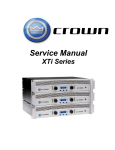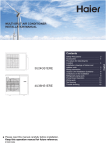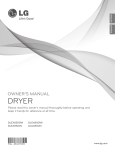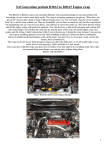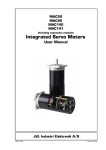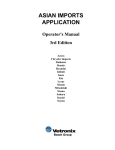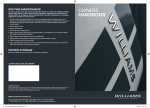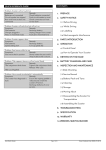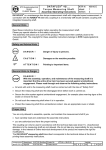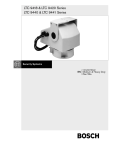Download Honda Engine Swap Guide
Transcript
HONDA ENGINE SWAP GUIDE THEULTIMATE HONDAENGINE SWAPGUIDE by Jared Holstein Humankind has made a habit of one-upping the creator when it can ben- US-spec Civic will be a whole lot easier, cheaper and more success- efit in some material sense. We figured out early on that playing match- ful than dropping an NSX engine into the same car—though this has maker to an ass and a horse produced a creature with the strength and not stopped people from trying. stamina of a horse, but the nimble sure-footedness of an ass. (That Unlike many manufacturers who often use a small number of dif- would be a donkey for those of you not up on your cross-breeding tech- ferent engines for their entire vehicle line, and do so for decades (ala niques.) Given that as enthusiasts, we all want our cars to run like a thoroughbred and handle like, well... an ass, the notion of installing a larger Chevy and the 350), Honda has produced just a few four-banger engine series, but a dizzying number of variants. Combine Japanese domestic market engine choices with the same engine designation engine in a lighter chassis is appealing. The same rules that apply in but higher output, as well as European market Hondas, and owners nature pertain to the automotive world as well: The more closely related have a smorgasboard of engine variants to choose from. Some the parent forms, the more likely they are to produce a viable hybrid. engines, of course, are scarcer and more desired than others, lead- Dropping a B16A from a Japanese domestic market Civic Type R into a ing to an unfortunate amount of Honda theft, though there are always engines with papers available (the only kind you want). Cars 1 Courtesy of SPORT COMPACT CAR / DECEMBER 2000 are not given the option of signing a donor card; should a Lincoln Nav- common thread: They are never as easy as they seem. To give you igator decide to back-half an Integra Type R, enthusiasts will arrive on a better idea of just what you are getting yourself into, the above table the scene to strip the carcass of the engine faster than "1-800-SUE- uses a rating scale that ranks the level of pain and anguish involved 4-YOU" lawyers can find whiplash victims. in each swap. Encouraged by the number of serious, performance-minded LEVEL 1: The engine bolts in using stock Honda or Acura compo- enthusiasts that comprise the Honda hybrid community, we are nents, with no modification to the car. This is so easy, it might even beginning a quest to comprehensively catalog every one of the rea- be fun. sonably feasible engine swaps. This quest begins in this issue, as LEVEL 2: The engine bolts in with the aid of a kit (from companies we show the relatively easy swap of a B18B1 into a fifth-generation such as HASport, Place Racing, or HCP.) This may be slightly more Civic hatchback (starting on page 136). Our engine swapping mad- costly, but the amount of work involved should be comparable to a ness will not be confined to Hondas, either, as there are some very level 1 swap. successful and well-tested hybrids with something other than H on LEVEL 3: The engine bolts in with the aid of a kit, but requires the valve cover. some modification to the car, such as clearancing the engine The following tables are our first stab at untangling the complex compartment, modifying the cross member, etc, or rewelding the web of engines, chassis, parts and kits that comprise the brave new mount locations. You will most likely need help with this one. hybrid world. The chart above will help you decide which swap to LEVEL 4: The chassis requires extensive custom modifica- attempt, while the table on the next page will help you find the donor tion to receive the engine. In other words, don’t come crying to engine. Look forward to more parts guides and other technical info us when you get halfway through tearing apart your car, only to for engine swaps in upcoming issues. The charts published in this find out that the crank pully hits your tire. issue can help render you a more educated buyer when selecting a engine, chassis, or transmission for your project (look for an upcoming Honda tranny guide to help better negotiate that particular quagmire). Engine swaps vary tremendously in complexity, but there is one 2 Courtesy of SPORT COMPACT CAR / DECEMBER 2000 The information gathering task behind this guide was extremely complex and would have been impossible without the help of a few key people. We would like to extend a special thanks to Aaron Bonk and John Spackman of Holeshot Racing, Brian Gillespie of HASport, Jason “Katman” Kaplan, Joe Rodgers and Tommy Liang. HONDA ENGINE SWAP GUIDE GENERATION YEAR MODEL COUNTRY OF SALE CHASSIS ENGINE DISPLACEMENT (CC) COMPRESSION RATIO HP/TORQUE TRANSMISSION ACCORD 5G ’94-’97 Accord DX/LX USA CD F22B2 2156 8.8:1 130hp@5300/139lb-ft@4200 5G ’94-’97 Accord EX USA CD F22B1 2156 8.8:1 145hp@5500/147lb-ft@4500 5G ’94-’97 Accord SiR Japan CD H22 2157 10.6:1 190hp@6800/152lb-ft@5500 4G ’90-’91 Accord USA CB F22A4 2156 8.8:1 130hp@5200/142lb-ft@4000 4G ’90-’93 Accord USA CB F22A1 2156 8.8:1 125hp@5200/137lb-ft@4000 4G ’91-’93 Accord USA CB F22A6 2156 8.8:1 140hp@5600/142lb-ft@4500 4G ’90-’93 Accord 2.0Si Japan CB F20A (twincam) 1997 9.5:1 150hp@6100/137lb-ft@5000 3G ’88-’89 Accord USA CA A20A3 1955 9.3:1 122hp CIVIC 6G ’99-’00 Civic Si USA EM B16A 1595 10.2:1 160hp@7600/111lb-ft@7000 6G ’96-’00 Civic EX Coupe USA EJ D16Z7 1590 9.6:1 127hp@6600/107lb-ft@5500 6G ’97+ Civic Type R Japan EK B16B 1595 10.8:1 184hp@8200/118lb-ft@7500 6G ’96+ Civic SiR II Japan EK B16A 1595 10.4:1 168hp@7800/116lb-ft@7300 6G ’96+ Civic Vti Europe EK B16A 1595 10.4:1 168hp@7800/116lb-ft@7300 5G ’92-’95 Civic Si USA EG/EH D16Z6 1590 9.2:1 125hp@6600/106lb-ft@5200 5G ’92-’95 Civic SiR Japan EG B16A 1595 10.4:1 168hp@7800/116lb-ft@7300 9.1:1 108hp@6000/100lb-ft@5000 S4C S4C Y21 and SiRII 4G ’89-’91 Civic Si USA ED D16A6 1590 4G ’88-’91 Civic DX USA ED D15A 1493 92hp@6000 L3 4G ’90-’91 Civic EX USA ED D16A6 1595 113hp@6200 L3 4G ’89-’92 Civic 1.6i/VTi Europe EE/ED B16A1 1595 10.2:1 158hp@7600/111lb-ft@7000 Y1 (opt. LSD) 4G ’88-’91 Civic Si Japan EF ZC 1595 9.6:1 129hp@6800/106lb-ft@5700 L3 4G ’89-’92 Civic SiR Japan EF B16A 1595 10.2:1 158hp@7600/112lb-ft@7000 Y1 (opt. LSD) 4G ’90-’91 Civic SiR Japan EF B16A1 1595 10.4:1 160hp@7600/111lb-ft@7000 3G ’86-’87 Civic Si USA AH EW4 1488 8.7:1 91hp@5500/93lb-ft@4500 3G ’86-’87 Civic Si Japan AT ZC 1595 9.6:1 129hp@6800/106lb-ft@5700 CG 5G ’94-’97 DelSol USA/Europe EG B16A3 1595 10.2:1 158ps@7600/112lb-ft@7000 Y21 USA EG D16Z6 1590 9.2:1 125hp@6600/106lb-ft@5200 Japan EG B16A 1595 10.4:1 168hp@7800 (hatch) GM CR-X/DEL SOL VTEC/Vti-T 5G ’92-’95 CR-X/ del Sol Si 5G ’92-’96 del Sol Y21 or S21 4G ’88-’91 CRX Si USA ED D16A6 1595 4G ’88-’91 CRX DX USA ED D15A1 1493 92hp@6000 L3 4G ’89-’92 CR-X 1.6i/VTi Europe EE B16A1 1595 10.2:1 158hp@7600/111lb-ft@7000 Y1 (opt. LSD) 4G ’90-’91 CR-X SiR Japan EF B16A1 1595 10.4:1 160hp@7600/111lb-ft@7000 4G ’89-’92 CR-X Si16/1.6i Japan EF ZC 1595 9.6:1 129hp@6800/106lb-ft@5700 CR-X SiR 3 Courtesy of SPORT COMPACT CAR / DECEMBER 2000 113hp@6200 HONDA ENGINE SWAP GUIDE GENERATION YEAR MODEL COUNTRY OF SALE CHASSIS ENGINE DISPLACEMENT (CC) COMPRESSION RATIO HP/TORQUE TRANSMISSION 1595 10.2:1 158hp@7600/112b-ft@7000 Y1 (opt. LSD) 4G ’89-’92 CR-X SiR Japan EF B16A 3G ’84-’87 CR-X HF USA EF D15A2 (carbed) 1488 58hp 3G ’85-’87 CR-X Si USA AD EW4 1488 91hp@5500/93lb-ft@4500 GM 3G ’85-’87 CR-X Si Japan AS ZC 1595 9.6:1 129hp@6800/106lb-ft@5700 CG INTEGRA 3G ’94-’00 Integra GS-R USA DC B18C1 1797 10.0:1 170hp@7600/128lb-ft@6200 Y80 3G ’94-’00 Integra USA DC B18B1 1834 9.2:1 142hp@6300/127lb-ft@5200 S80, Y80 LS/RS/GS 3G ’97-’98, ’00 Integra Type R USA DC B18C5 1797 10.6:1 195hp@8000/130lb-ft@7500 S80 3G ’95-’97 Integra SiR DC B18C 1797 10.6:1 178hp@7600/129lb-ft@6200 Y80,S80(opt.LSD) 3G ’95-’00 Integra Type R Japan DC/DB B18C 1797 11.0:1 197hp@8000/134lb-ft@7500 S80 LSD 2G ’90-’91 Integra GS USA DB B18A1 1834 9.2:1 130hp@6000/121lb-ft@5000 YS1 2G ’92-’93 Integra GS USA DB B18A1 1834 9.2:1 140hp@6300/121lb-ft@5200 YS1 2G ’92-’93 Integra GS-R USA DB B17A1 1678 10.0:1 160hp@7600/117lb-ft@7000 YS1 2G ’90-’93 Integra Japan DB ZC 1590 9.0:1 119hp@6300/105lb-ft@5500 S1, A1, J1 2G ’90-’91 Integra XSi/RSi Japan DA B16A 1595 10.2:1 158hp@7600/112lb-ft@7000 S1, A1, J1 2G ’92-’93 Integra XSi/RSi Japan DA B16A 1595 10.2:1 158hp@7600/112lb-ft@7000 YS1 (opt. LSD) 1G ’88-’89 Integra USA DA D16A3 1590 9.5:1 118hp@5500/103lb-ft@5500 CG 1G ’86-’87 Integra USA DA D16A1 1590 9.5:1 113hp@6250/99lb-ft@5500 CG 1G ’86-’89 Integra Japan AV ZC 1590 9.6:1 129hp@6800/106lb-ft@5700 CG 5G ’99+ Prelude USA BB6 H22A 2157 10.0:1 200hp@7000/156lb-ft@5250 5G ’97-’98 Prelude USA BB6 H22A1 2157 10.0:1 195hp@7000/156lb-ft@5250 5G ’97+ Prelude SiR Japan BB H22A 2157 10.6:1 200@6800rpm/161lb-ft@5500 5G ’97+ Prelude Type S Japan BB H22A 2157 11.0:1 220@7200rpm/163lb-ft@6500 4G ’92-’96 Prelude S BB F22A1 2156 8.8:1 135hp@5200/142lb-ft@4000 4G ’92-’96 Prelude Si/SE USA BB2 H23A1 2258 9.8:1 160hp@5800/156lb-ft@4500 4G ’94-’96 Prelude VTEC USA BB1 H22A1 2156 10.0:1 190hp@6800/158lb-ft@5500 4G ’92-’96 Prelude Si Japan BA F22 2156 Japan PRELUDE USA 160hp@6000/148lb-ft@5000 (DOHC, non VTEC) 4G ’92-’96 Prelude VTEC Japan BB H22 2157 10.6:1 200@6800/161lb-ft@5500 3G ’90-’91 Prelude 2.0S USA BA B20A3 1958 9.1:1 104hp@5800/111lb-ft@4000 3G ’90-’91 Prelude 2.0Si USA BA B20A5 1958 9.0:1 135hp@5800/111lb-ft@4000 3G ’90-’91 Prelude Si USA BA B21A1 2056 9.4:1 140hp@5800/135lb-ft@5000 3G ’88-’89 Prelude Si USA BA B20A5 1958 9.0:1 135hp B20Z 1972 9.6:1 146hp@6200/133lb-ft@4500 B20B 1972 8.8:1 126hp@5400/133lb-ft@4300 THE ODDBALLS ’99+ SMX Japan ’97-’98 CR-V USA RD 4 Courtesy of SPORT COMPACT CAR / DECEMBER 2000 K4 HONDA ENGINE SWAP GUIDE NOTES: HYBRIDHOW-TO by Jared Holstein PHOTOGRAPHY: JARED HOLSTEIN ENGINE SWAP #1: B18B1 ENGINE, 5G CIVIC CHASSIS We begin our Hybrid How-To series with one of the most common and easiest Honda engine swaps: The Integra B18 engine in a fifth-generation Civic. You might expect us to begin with the VTEC-equipped B18C1 from the Integra GS-R, but those engines are alarmingly rare, highly sought-after, and consequently very expensive. As the base engine in the 94-and-up Integras, the non-VTEC B18B1 does not garner much love in the Acura camp, which also means they don’t garner a very big price tag. 5 Courtesy of SPORT COMPACT CAR / DECEMBER 2000 HONDA ENGINE SWAP GUIDE NOTES: The B18B1’s numbers, however are respectable: 142 hp and 127 lb/ft of torque. Drop this engine into a much lighter Civic blessed from the factory with at best a 125 hp, torqueless D16Z6, and this car scoots. Not only are they in less demand, but there were far more basemodel Integras sold than GS-Rs, so finding a B18B1 is much easier and less painful on the wallet than finding one of their VTEC cousins. Best of all, these engines are a straightforward swap into the fifth generation (’92 to ’95) and sixth generation (’96 and up) Civics as well as the second-generation Integras, using parts available from the dealer or wrecking yard. In addition, engine mount kits can be purchased to make dropping this engine into third and fourth generation Civics as well as first-generation Integras a bolt-in affair. Though a straightforward swap, there are nonetheless a few tricks which make the swap go that much smoother. We sat in to document this swap on a fifth-generation Civic at Holeshot Racing in Anaheim, Calif., where Jon Spackman and Aaron Bonk made short work of the process. We strongly suggest you have a good service manual on hand for general engine removal and installation instructions, which are useful for any application. Having a lift makes the swap process quicker and easier, though it is certainly not a requisite. Cherry pickers can be bought for about $150, or rented reasonably by the hour or day at most rental yards. When disconnecting the various liquid, vacuum, and electrical connections in the engine compartment, do so prudently. If you decide to roughhouse the hoses and other delicate items, you will find yourself replacing annoyingly small and expensive parts, with requisite trips to the dealer delaying the engine installation. 6 Courtesy of SPORT COMPACT CAR / DECEMBER 2000 HONDA ENGINE SWAP GUIDE Before dropping the engine, you must first disconnect the shift linkage. The trick is to insert a quarter-inch round, non-tapered drift (like the one on the right in the photo) into the hole seen at the center to knock loose the linkage. Unlike D15s, which are of little value to anyone, D16Zs are worth holding onto; they are worth at least $500 used, and often more to people planning on using supercharger kits and the like. Having your new engine attached to the tranny with the clutch already installed prior to the swap will speed up the process and simplify the clutch installation. NOTES: 7 Courtesy of SPORT COMPACT CAR / DECEMBER 2000 HONDA ENGINE SWAP GUIDE > Take special care with the evaporative purge valve located near the intake manifold. The plastic neck inside is weak and will break easily when the attached rubber hose is being disconnected (silicone spray works wonders). If your car is an automatic and you want to swap in an LS engine with a five-speed, you need to procure a pedal assembly, the assorted hydraulic lines, shift linkage, clutch master cylinder, slave cylinder, and a weld-on tranny mount available from the dealer. NOTES: 8Courtesy of SPORT COMPACT CAR / DECEMBER 2000 As is apparent in the picture, the Civic throttle cable is a few inches shorter than the Integra cable. Installing the correct Integra cable is inexpensive and duplicates what Honda engineers probably worked many hours to engineer. HONDA ENGINE SWAP GUIDE S O U R C Holeshot Racing 1525 N Endeavour Pl, Unit M Anaheim, CA 92801 (714) 772-VTEC When installing the B18B, stock engine mounts will work for all except the front stabilizer mount, which requires a ’94-plus Integra bracket, but uses the stock Civic rubber. Many hybrid enthusiasts decide to simplify the swap process by foregoing power steering and air conditioning. If, however, you want to retain power steering, you should use the ’94-plus Integra pump and mounting bracket. If you want to retain air conditioning, a bracket from the ’94-’97 del Sol VTEC will correctly mount the compressor. NOTES: 9 COURTESY OF SPORT COMPACT CAR / DECEMBER 2000 E













